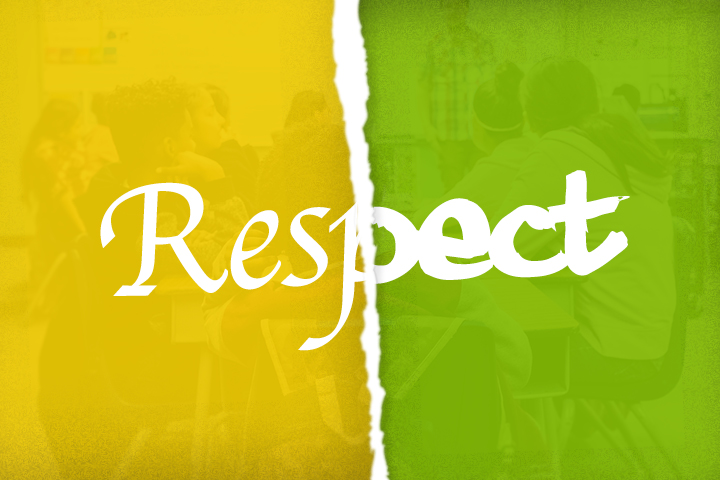A story of when you send a team of talented social scientists into American high schools to study character.


This essay is one of a series of posts based on the recently published book The Content of Their Character: Inquiries into the Varieties of Moral Formation. The book is a project of the Institute for Advanced Studies in Culture, in Charlottesville, Virginia. This edition was originally published on March 26, 2018.
When you send a team of talented social scientists into a national sample of American high schools to study the molding of student character, you probably expect them to see certain classic virtues in action. At the same time, you probably expect some contrasts to emerge, given our country’s diversity.
But however straightforward your expectations might be, the results can be striking, as the University of Virginia’s Institute for Advanced Studies in Culture found when it embarked on just such a project.
Take respect. Respect for others is typically emphasized to young people, and the team members did remark on students’ expressions of respect in virtually all of the public and private high school types in the project’s sample. The findings on respect, however, stood out in two school sectors: urban public schools and rural public schools.
The rural public schools were studied by Richard Fournier, now a teaching fellow at Harvard University’s School of Education. In The Content of Their Character: Inquiries into the Varieties of Moral Formation, the Institute’s book on the research findings, Fournier lists five ideals that were “prominent” in the schools: hard work; personal responsibility; compassion and caring for others; service to the school, community, and country; and “showing respect, most notably for teachers, administrators, the school itself, and the school community.” He adds, “Indeed, many parents were clear that whatever a school’s rationale, efforts to emphasize certain moral ideals were necessary”—including the central value of “showing respect.”
This idea was also clear in the minds of administrators. One assistant principal told Fournier, “We have traditional values, and we have traditional—I think a lot of our practices are traditional. So if there’s anything that we would really promote or, you know, try to instill in our students, I think is respect.”
Indeed, school staff could lean on the students’ respect for their family elders. One principal told Fournier that in response to a student who asks “‘why, why do you want me to be that?’” his answer is “well, because! Because your grandparents want you to! Because your parents want you to! Because that’s how you’re successful!”
In the urban public school sector, respect was prominent too—but with a twist. To be sure, respect was again considered important: As Jeff Guhin, an assistant professor of sociology at the University of California Los Angeles, writes in The Content of Their Character, “Another value I heard about regularly from both students and teachers at all six [urban public sample] schools was respect.” Guhin further indicates that in many instances, students in these urban high schools manifested respect in traditional terms.
Yet the conventional ideal was not the one he “heard about regularly.” Instead, Guhin remarks, “in all [these] cases, respect meant making sure others thought you were worthy of their esteem and appreciation.” (Emphasis added.) This sense of respect meant that instead of making clear to others that you thought they were worthy of esteem and appreciation, you ensured you were not being disrespected.
The contrast with the findings in the rural public schools was sometimes stark, and the urban schools’ staff were aware of how clearly at odds this view of respect was with the values of American society at large. One teacher told Guhin,
Some [students], when you have them, they hate you. They make your life as difficult as possible, and then the second you don’t have them, they’re going to come and talk to you. I feel like I’m OK with bonding with my kids when I have them, but after I have them, I think that’s when it happens, and they’ll come in and they’ll talk about, “Well, I got really mad at this teacher, and I cussed her out.” You cussed her? Why do you think that that’s okay? A student yesterday called me by my first name, and I tried and explained that that is a sign of disrespect. I don’t even think I got myself across, but it’s small things like that where [if you want] to live, to be successful in life, you have to learn how to speak to people, what’s respectful, what’s disrespectful. (Parentheticals added.)
Guhin also tells of an extended discussion he witnessed between a school principal and a 10th grade student named Juana (an alias). Juana had been in a fight with a girl with whom she’d had a running feud, and the principal was encouraging Juana to resolve the dispute. Guhin recounts Juana’s response:
“I can talk to her, but if she lies to me, I’m going to punch her in the face,” said Juana. “I can’t let that happen. How you gonna lie right to my face? No, no. I’m sorry, Ms, but no. I won’t do it.”
The principal continued to reason with Juana (Guhin notes that of the schools he studied, this one “was by far the most explicitly concerned about the moral formation of their students”). The principal expressed that, in Guhin’s words, “she was worried Juana’s stubbornness and impulsiveness would get her in trouble.” He adds that then “a teacher who had broken up the fight came in, and both the teacher and principal tried to convince Juana that she needed to be calm and just let people say what they wanted to say, but Juana wouldn’t hear it.”
He observes,
Yet the way her principal and teacher framed this story to Juana wasn’t necessarily the only way to understand it. Juana wasn’t just struggling with impulse control and stubbornness, as though everyone were actually on the same page in terms of virtues to emphasize and vices to limit. Rather, this was a story about radically different conceptions of the good. For Juana, the good person, and the good life, was marked by respect, honor, and the saving of face. To disrespect her, to lie to her, was not simply to do something annoying that required her patience to overcome; it was to fundamentally insult her worth as a person, and the only way to respond was to demand reparation for that wrong, whether through violence or otherwise.
I asked the principal about this after Juana had left, and she said that contending with this attitude was one of the biggest challenges at their school. She said she had to be careful, because she would never tell a student she disagreed with their parents.
Note that last sentence. Not only were the school’s staff contending with Juana’s and other students’ fundamentally different views about the meaning of “respect”; they were contending with the same views among many of the parents. In cases like these, the polarity between the study’s rural schools and urban schools could hardly seem more complete.
Yet it is not obvious that this should have been so. Urban areas may face poverty and its attendant social ills, but rural areas do too. As Fournier comments,
In general, rural school teachers and administrators face the same tasks as urban districts: to increase academic performance among students and prepare them for social and economic life despite their communities’ frequent issues with poverty, drugs, unemployment, and other socioeconomic obstacles.
There is, of course, the issue of race: The urban schools had much higher percentages of black, Hispanic, and other minority students than the rural districts. These minority students and their families may have had to cope with the frequently corrosive repercussions of prejudice.
But whatever the effects of prejudice, there is nothing inherently racial in demanding “respect, honor, and the saving of face.” Whites can, and have, adopted similar views—dueling, after all, was part of America’s European heritage—while blacks and Hispanics can, and have, rejected them.
Ultimately, then, the difference between the two sets of schools—and between the families within the schools—was cultural. This is worth bearing in mind. The centrality of culture in our schools is something we too frequently forget, particularly when we think about the moral formation of our young. Perhaps the allure of education statistics is too strong, or perhaps we are swayed by the “factory view” of a single common school system working on individual students who share the same basic specifications.
But as this tale of two virtues shows, and as The Content of Our Character contends, if we seek to understand and improve our children’s moral formation, we must first seek to understand the culture—or cultures—in which our children are raised, and indeed, to try to understand the nature and effects of culture itself.
###
For further reading on CultureFeed